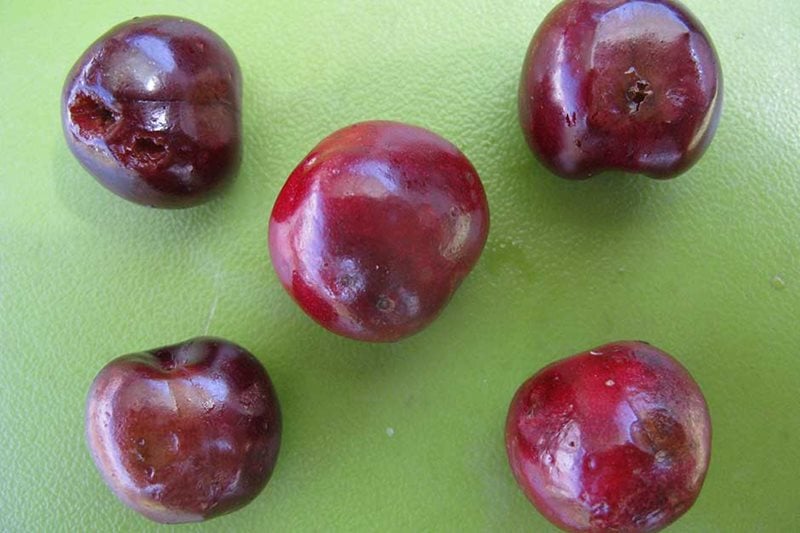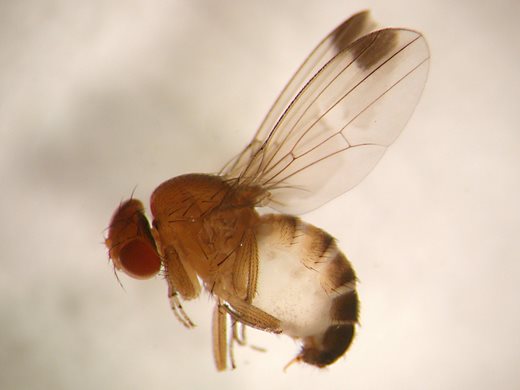An unwelcome new arrival with a taste for garden fruit crops is worth looking out for, says RHS Chief Horticulturist Guy Barter

The spotted wing drosophila (
Drosophila suzukii) is a fruit fly, very similar to the native common fruit fly which is often found on decaying fruit. Unfortunately, unlike the native, the spotted wing drosophila also feeds on developing fruit. This means it can be much more damaging to garden crops.
Spotted wing drosophila is native to Japan but is now a global pest, found in Britain since 2012. There can be several generations per summer. In autumn the extremely hardy adults seek shelter in hedges, shrubberies and woods for the winter, then begin sipping nectar the following spring ready to attack fruits as they ripen.
 How do I identify it?
How do I identify it?
Use a magnifying glass and look for large black spots on the leading edge of the males' wings. Females are more difficult to identify in the field – they are distinguished by the serrated egg-laying appendage that they use to penetrate the fruit. Maggots are indistinguishable from native fruit fly maggots.
Eggs are laid just below the skin of the fruit, and soon hatch into maggots. Fruit is ruined by puncture wounds, wriggling larvae, seeping juices and finally collapse and rotting.
What does it attack?
Our experience here at the RHS suggests that cherries are the most vulnerable crop, but blackberries, blueberries, grapes, raspberries, strawberries and hybrid berries such as loganberries are reported to be highly vulnerable. Unfortunately, all currants and gooseberries, kiwifruit, plums and other stone fruit support this pest.
Wild plants are also at risk; blackberries, dogwoods, wild cherries, elders, hawthorns, honeysuckles, sloes and wild sorbus. Some ornamental garden plants including roses and snowberries are carriers too. However, some plants, pyracantha for example, are attractive to spotted wing drosophila but the flies cannot complete their life cycle. Researchers hope these ‘dead-end crops’ may help control this pest.
How do I control it?
Hygiene is the first step in control. Gather up and use all ripe fruit; not forgetting any apples, crab apples, pears and tomatoes left after harvesting is crucial. Bury any surplus or infested fruit. Never compost fruit waste.
Alternatively, placing fruit in a sealed plastic bag to fester in the sun soon renders it inhospitable to fruit flies. This can reduce pest numbers, but it helps to enlist your neighbours in the process too.
Enclosing fruit in sleeves of horticultural fleece or other very
fine mesh as soon as they form can be very effective, if laborious and costly. On a larger scale, trapping, from April until November, using several traps per plant positioned on the shady side of crops. Traps can be bought or made at home using a bait of red wine and vinegar. Trapping along the garden boundary will intercept the flies invading from nearby hedges and woods, and attracting flies already present away from your fruit bushes.
Sieve the contents of the traps to find the flies, washing away debris with a gentle jet of water. Use a magnifying glass to search for the tell-tale black spots on the wings of the males.
In gardens, sleeving fruit when spotted wing drosophila is found in traps and trapping itself usually offers sufficient control. However, when all else fails approved garden insecticides are available, which if applied before spotted wing drosophila eggs are hatched can be effective.
Check that the crop in question is approved on the label before you buy an insecticide. Cherries for example can be protected with several products including SBM Greenfly Killer (deltamethrin).
See also
RHS advice on using chemicals in gardens
Using chemicals safely
See our
A-Z of fruit crops to grow at home

